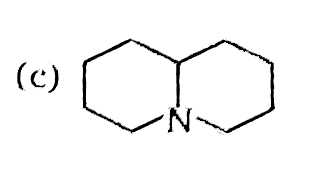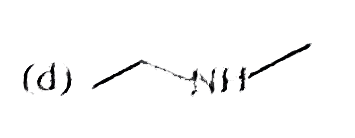Explain Hoffmann’s exhaustive alkylation with suitable reactions.
Step-by-Step Text Solution for Hoffmann’s Exhaustive Alkylation
Step 1: Understanding the Concept
Hoffmann’s exhaustive alkylation is a method used to synthesize quaternary ammonium salts from primary amines by reacting them with alkyl halides. The process involves multiple alkylation steps, where a primary amine is gradually converted into a quaternary ammonium salt.
Step 2: Starting Material
Let’s consider chloroethane (C2H5Cl) as our alkyl halide and ammonia (NH3) as our amine.
Step 3: First Reaction - Formation of Primary Amine
When chloroethane reacts with ammonia, the lone pair of electrons on the nitrogen atom of ammonia attacks the carbon atom of chloroethane. This results in the formation of ethylamine (C2H5NH2) and the release of a chloride ion (Cl-).
Reaction:
C2H5Cl+NH3→C2H5NH2+Cl-
Step 4: Second Reaction - Formation of Secondary Amine
The newly formed ethylamine can react again with another molecule of chloroethane. The nitrogen atom in ethylamine, which now has one ethyl group attached, can attack another chloroethane, leading to the formation of N-ethyl-ethylamine (C2H5)2NH and another chloride ion.
Reaction:
C2H5Cl+C2H5NH2→(C2H5)2NH+Cl-
Step 5: Third Reaction - Formation of Tertiary Amine
The secondary amine (N-ethyl-ethylamine) can further react with another molecule of chloroethane. This results in the formation of N,N-diethylamine (C2H5)3N and the release of another chloride ion.
Reaction:
C2H5Cl+(C2H5)2NH→(C2H5)3N+Cl-
Step 6: Final Reaction - Formation of Quaternary Ammonium Salt
Finally, the tertiary amine (N,N-diethylamine) can react with another molecule of chloroethane. This leads to the formation of a quaternary ammonium salt, specifically N,N,N-triethylammonium chloride (C2H5)3N+Cl-.
Reaction:
C2H5Cl+(C2H5)3N→(C2H5)4N++Cl-
Final Product:
The final product is a quaternary ammonium salt represented as (C2H5)4N+Cl−.
Summary
Hoffmann’s exhaustive alkylation involves the stepwise alkylation of a primary amine to form secondary, tertiary, and finally quaternary ammonium salts through repeated reactions with alkyl halides.
---
Hoffmann’s exhaustive alkylation is a method used to synthesize quaternary ammonium salts from primary amines by reacting them with alkyl halides. The process involves multiple alkylation steps, where a primary amine is gradually converted into a quaternary ammonium salt.
Let’s consider chloroethane (C2H5Cl) as our alkyl halide and ammonia (NH3) as our amine.
When chloroethane reacts with ammonia, the lone pair of electrons on the nitrogen atom of ammonia attacks the carbon atom of chloroethane. This results in the formation of ethylamine (C2H5NH2) and the release of a chloride ion (Cl-).
C2H5Cl+NH3→C2H5NH2+Cl-
The newly formed ethylamine can react again with another molecule of chloroethane. The nitrogen atom in ethylamine, which now has one ethyl group attached, can attack another chloroethane, leading to the formation of N-ethyl-ethylamine (C2H5)2NH and another chloride ion.
C2H5Cl+C2H5NH2→(C2H5)2NH+Cl-
The secondary amine (N-ethyl-ethylamine) can further react with another molecule of chloroethane. This results in the formation of N,N-diethylamine (C2H5)3N and the release of another chloride ion.
C2H5Cl+(C2H5)2NH→(C2H5)3N+Cl-
Finally, the tertiary amine (N,N-diethylamine) can react with another molecule of chloroethane. This leads to the formation of a quaternary ammonium salt, specifically N,N,N-triethylammonium chloride (C2H5)3N+Cl-.
C2H5Cl+(C2H5)3N→(C2H5)4N++Cl-
The final product is a quaternary ammonium salt represented as (C2H5)4N+Cl−.
Hoffmann’s exhaustive alkylation involves the stepwise alkylation of a primary amine to form secondary, tertiary, and finally quaternary ammonium salts through repeated reactions with alkyl halides.
Similar Questions
Knowledge Check
Which of the following compound gives even number of hoffmann's exhaustive methylation an elimintion ?
A B
B C
C D
D
Match the column:
HEM = Hoffmann exhaustive methylation followed by eliminaation ,

View SolutionExplain redox reaction with suitable example.
View SolutionExplain redox reaction with suitable example.
View SolutionExplain the following reactions with suitable examples.
Gatterman reaction
View SolutionExplain the following reactions with suitable examples.
Sandmeyer reaction.
View SolutionWrite one chemical reaction each to illustrate the following :
(i) Hoffmann Bromamide reaction.
(ii) Gabriel phthalimide reaction.
View SolutionExplain the following reactions with suitable examples.
Hofmann elimination reaction.
View Solution
